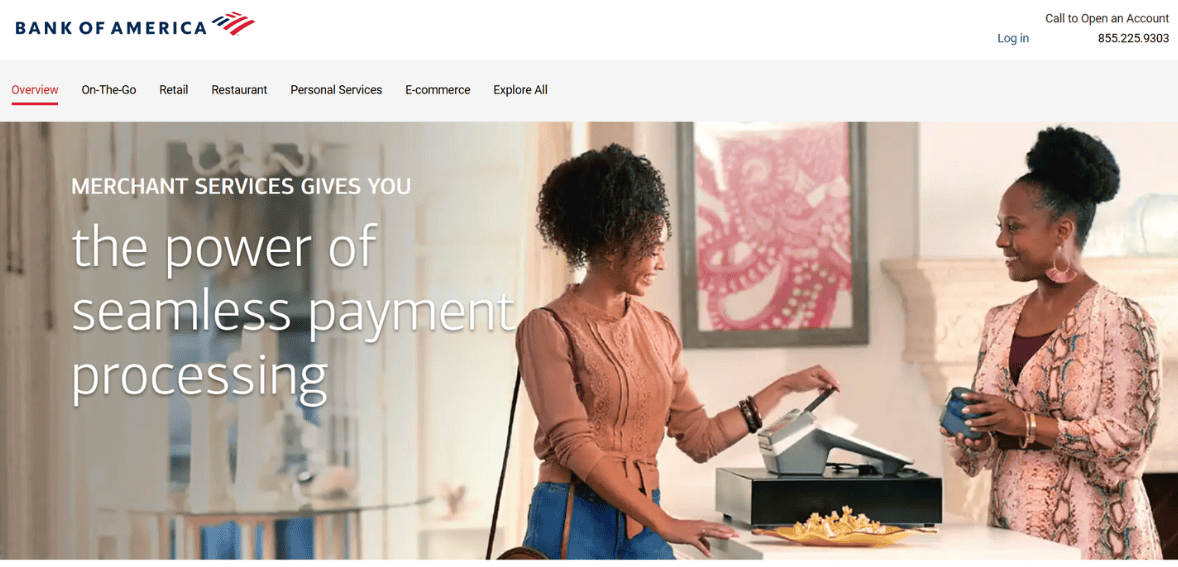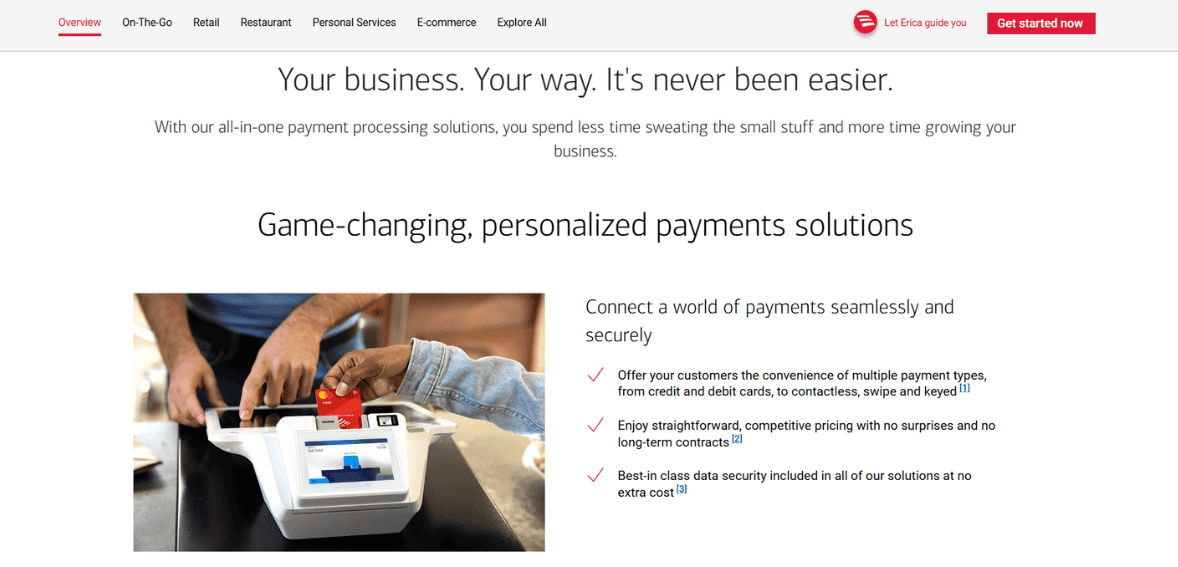
Bank of America Merchant Services Review
- 21st Oct, 2025
- | By Linda Mae
- | Reviews
Bank of America Merchant Services has been a household name in the US payment processing space for years. Historically it leveraged the strength of one of the largest banks in the country along with partnerships with payment technology providers to offer a wide range of merchant solutions. Its services allowed businesses in retail, hospitality, e-commerce and professional services to accept payments securely and efficiently. Lets read more about Bank of America Merchant Services Review.
In a market now dominated by fintech disruptors like Square, Stripe and PayPal, Bank of America Merchant Services still appeals to many businesses that value institutional stability and traditional banking integration. They offer card processing, point of sale hardware, online payment gateways and fraud prevention tools to support businesses of all sizes.
But Bank of America Merchant Services isn’t without criticism. Many merchants praise the strength of its infrastructure and reliability while others complain about complex contracts, opaque pricing and less agile support compared to modern competitors. For businesses it’s a choice between brand trust and enterprise grade solutions vs flexibility and cost transparency. This review goes into detail on Bank of America Merchant Services; its history, offerings, pros and cons; to help business owners decide if it’s the right fit for their payment processing needs.
Table of Contents
ToggleCompany Background and Market Position | Bank of America Merchant Services Review
Bank of America Merchant Services has been around for a long time, built on a joint venture between Bank of America and First Data (now part of Fiserv). This allowed the company to combine a large merchant portfolio with advanced processing technology and have one of the largest footprints in the US. For many years it was one of the top providers of merchant services in the country, trusted by thousands of small and large businesses.
But in recent years the landscape has changed dramatically. The joint venture dissolved in 2020 and now Bank of America operates differently, often routing their merchant services through other providers or partners. This has caused confusion for business owners, especially those who were used to the old model of bundled banking and payment services.
Despite these changes the Bank of America brand still carries a lot of weight. Businesses feel comfortable with the association with a big bank, especially compared to newer fintech competitors. But Bank of America Merchant Services is no longer as dominant as it once was, newer entrants offer more transparent pricing and modern user interfaces. But it still has relevance for established businesses that value brand security and prefer traditional banking relationships over the disruptor models.
Account Setup and Onboarding Process
Setting up with Bank of America Merchant Services is like the old school banking experience. Prospective merchants go through a more formal application process than they would with a newer fintech processor. Required docs are business registration, bank account info, tax id numbers and sometimes credit checks. This can be overwhelming for very small businesses or sole proprietors who find the process slower than expected.
Onboarding is not standardized. Some merchants report quick approvals especially if they already have a Bank of America account. Others report longer wait times, sometimes weeks, before their account is activated. Compared to newer providers that allow online signups in minutes, this can be a drawback. The benefit is the extra oversight. A thorough application process reduces the chance of account freezes or rolling reserves that happen with fintech processors. Merchants also get dedicated reps to guide them through the process, a personal touch that smaller providers can’t match.
For businesses looking for a traditional and bank backed onboarding experience this process may be reassuring. But for those that prioritize speed and convenience especially in the startup stage, the setup may feel outdated in today’s fast paced business world.
Payment Processing Capabilities
At its heart, Bank of America Merchant Services offers a wide range of payment acceptance. This includes credit and debit card processing for Visa, Mastercard, American Express and Discover, as well as mobile wallets like Apple Pay and Google Pay. They also offer ACH and e-check for businesses that do recurring billing or B2B transactions.
Merchants can accept payments in-store, online or on mobile devices, so they have an omnichannel solution. This is especially helpful for businesses that operate in multiple environments, like retailers with brick-and-mortar stores and e-commerce platforms. Transaction reliability is generally good, given the institutional backing of the processing network.
In addition to basic acceptance, Bank of America Merchant Services offers recurring billing, invoicing and card-not-present transactions. This allows you to handle complex billing cycles, which is especially important for professional services, healthcare providers and subscription-based businesses.
But some merchants have noted challenges with integrating newer, niche payment methods vs. agile fintech competitors. Cryptocurrencies, BNPL solutions and alternative wallets are not as supported. For most traditional businesses, this won’t be a problem, but for those targeting younger, tech-savvy customers, it can be a limitation. Overall, the payment processing is robust but leans towards traditional options.

POS and Hardware Options
Bank of America Merchant Services provides a range of hardware options for in-person transactions. Merchants can choose from countertop terminals, wireless devices, mobile card readers, and full-scale POS systems. Many of these are powered through partnerships, particularly with Clover POS systems, which have become widely adopted for their functionality and scalability.
For small businesses, mobile card readers that pair with smartphones or tablets offer affordable flexibility. These solutions allow merchants to accept payments on the go, making them suitable for field services, pop-up shops, or food trucks. Larger retailers and restaurants can opt for integrated Clover POS systems that include inventory management, employee tracking, and advanced reporting tools.
The hardware generally comes at a higher cost compared with simple plug-and-play devices offered by fintech startups. Additionally, merchants are often tied into long-term equipment leases, which can increase overall costs significantly over time. Many negative reviews highlight frustrations with non-cancellable leases and outdated terminal models.
On the positive side, the hardware is reliable and backed by enterprise-level support. Businesses with complex needs, such as multi-location retailers or restaurants, may find value in the scalability and functionality of the systems offered. Ultimately, while hardware options are broad, prospective merchants should carefully review lease agreements and costs to avoid long-term financial burdens.
Online and E-Commerce Solutions
For businesses operating online, Bank of America Merchant Services provides tools to facilitate secure and reliable transactions. Its e-commerce solutions include payment gateways, hosted checkout pages, and APIs that allow integration with popular shopping carts and platforms. Merchants can embed payment forms directly into their websites or use third-party plug-ins for seamless integration.
The system also supports recurring billing for subscription-based businesses, as well as tokenization to securely store customer payment details. These features are important for reducing checkout friction and maintaining customer trust. Fraud prevention tools, including address verification and CVV checks, add another layer of security.
While functional, the online platform is not always as user-friendly or flexible as those offered by competitors like Stripe or Shopify Payments. Some merchants find the integration process less intuitive, requiring developer support for custom setups. Others cite difficulties with adapting the platform for newer payment methods or international transactions.
Nonetheless, for established businesses already within the Bank of America ecosystem, the e-commerce solutions provide a familiar and stable option. The system works best for companies seeking standard payment acceptance with strong security backing, rather than businesses looking for cutting-edge flexibility or advanced developer features.
Pricing Structure and Fees
Pricing is one of the most debated aspects of Bank of America Merchant Services. Unlike newer providers that often advertise flat-rate, transparent pricing, Bank of America typically uses a traditional interchange-plus or tiered pricing model. This means transaction fees can vary significantly depending on the card type, transaction volume, and risk profile of the business.
Merchants may face multiple charges, including monthly account fees, PCI compliance fees, statement fees, and equipment lease costs. While larger businesses may benefit from negotiated rates, smaller merchants often find the structure confusing and potentially more expensive than fintech competitors. Early termination fees are another common criticism, particularly when merchants sign multi-year contracts without realizing the implications.
The lack of clear, upfront pricing has been a source of frustration. Some businesses report receiving competitive rates, but others feel misled by sales representatives who failed to disclose additional costs. This inconsistency makes it essential for merchants to carefully review contracts and clarify all fees before signing.
On the positive side, businesses processing high volumes may achieve cost savings under interchange-plus pricing, as it can be more efficient than flat-rate models. Still, for small merchants seeking predictability and simplicity, the complexity of Bank of America’s pricing can be a deterrent.
Security and Compliance Features
Security is a critical element of payment processing, and Bank of America Merchant Services provides strong measures to protect both merchants and customers. The company emphasizes PCI DSS compliance, offering guidance and tools to help businesses maintain adherence to required security standards. Tokenization and point-to-point encryption are employed to reduce the risk of cardholder data breaches.
Fraud prevention solutions include advanced verification tools such as AVS and CVV checks, along with real-time monitoring systems to flag suspicious transactions. For e-commerce merchants, additional features like 3D Secure and customizable fraud filters can further safeguard online payments. Another advantage of working with a bank-backed provider is the added sense of institutional trust. Businesses may feel more comfortable handling sensitive financial data through a processor associated with a recognized financial institution.
On the downside, some merchants report that achieving compliance through the provided tools can feel cumbersome. Completing annual PCI questionnaires and meeting security requirements may be more complex than with streamlined fintech platforms. Additionally, while security tools are strong, they are not always as adaptable to newer forms of digital payments or alternative currencies. Overall, Bank of America Merchant Services offers robust security, but the experience may be less user-friendly for smaller merchants without technical expertise.
Reporting and Analytics
Effective reporting and analytics tools can help businesses gain deeper insights into their financial performance. Bank of America Merchant Services offers dashboards and reporting systems that allow merchants to track transactions, monitor trends, and reconcile payments with their bank accounts. These tools are especially valuable for businesses managing high volumes of transactions or operating across multiple locations.
Reports can be customized to include daily summaries, chargeback details, and batch processing updates. For large enterprises, advanced reporting tools provide granular insights that can help inform decision-making, budgeting, and forecasting. Integration with accounting software can further streamline financial management, reducing manual reconciliation tasks.
That said, the reporting platform is not always considered as intuitive as modern fintech dashboards. Some users find the interface dated, with fewer visualization tools compared to competitors. Real-time reporting can also lag at times, which may frustrate merchants needing instant insights.
Nevertheless, the reliability of the data itself is rarely questioned, and the tools are sufficient for most standard business needs. For companies seeking cutting-edge analytics, this may fall short, but for those requiring consistency and detail, Bank of America Merchant Services provides a stable reporting foundation.
Customer Support and Service Reliability
Customer support is another area where experiences are mixed. Bank of America Merchant Services provides phone, email, and in some cases, live chat support. Large merchants may be assigned dedicated account representatives, which can help with issue resolution and ongoing account management.
Some businesses report satisfactory experiences, noting professional and knowledgeable representatives who handle issues effectively. Others, however, complain of long wait times, inconsistent answers, and difficulty reaching the right department. This inconsistency has affected the company’s reputation, especially when compared to competitors that emphasize 24/7 support with fast response times.
Service reliability, on the other hand, tends to be strong. Downtime and transaction failures are relatively rare, reflecting the enterprise-grade infrastructure behind the service. For businesses where uninterrupted processing is critical, this is a significant advantage. The key takeaway is that while the system itself is reliable, the human support aspect may vary depending on the merchant’s size and assigned representative. Small businesses may find themselves with less personalized assistance than larger clients.

Integrations and Business Tools
Bank of America Merchant Services integrates with a variety of third-party tools and platforms to extend its functionality. These include accounting software such as QuickBooks, ERP systems for larger enterprises, and POS systems like Clover. These integrations help streamline workflows by automatically syncing transaction data with back-office systems.
In addition to core payment processing, the service offers value-added tools such as invoicing, recurring billing, and fraud management. For businesses looking to simplify operations, these features can reduce the need for multiple vendors. Integration with mobile wallets and e-commerce platforms ensures businesses can accommodate customer preferences both online and offline.
However, the breadth of integrations is not always as comprehensive as with modern API-driven competitors. Businesses with niche requirements or advanced customization needs may find limitations, particularly compared to platforms like Stripe, which emphasize developer-friendly APIs.
Still, for merchants already using mainstream tools, the available integrations are generally sufficient. The focus is more on stability and reliability than on experimentation or flexibility. For businesses seeking a secure and established ecosystem, these tools can provide a functional foundation, even if they lack the innovation of fintech alternatives.
Pros of Using Bank of America Merchant Services
One of the biggest strengths of Bank of America Merchant Services is the brand trust it carries. Businesses often feel more secure working with a processor backed by a nationally recognized bank. The infrastructure is reliable, with strong uptime and consistent transaction performance.
The breadth of services is another advantage. From in-store POS hardware to online gateways, recurring billing, and fraud prevention tools, the company offers a full range of solutions for businesses operating across multiple channels. For large enterprises, the availability of advanced reporting and dedicated account management can also be highly beneficial.
Additionally, high-volume merchants may benefit from competitive interchange-plus pricing, potentially achieving better rates than flat-rate competitors. Security features are robust, ensuring businesses remain PCI compliant and protected from common fraud threats. For businesses that prioritize institutional stability, comprehensive services, and long-term banking relationships, Bank of America Merchant Services remains an appealing option.
Cons and Common Complaints
Despite its strengths, Bank of America Merchant Services has faced recurring criticisms from merchants. One of the most common complaints is the complexity of its pricing structure. Many small businesses struggle to understand the range of fees, and unexpected charges often appear on statements. Equipment leases are another source of frustration, particularly when merchants feel locked into long-term contracts with limited flexibility.
Customer support receives mixed reviews. While some merchants praise the professionalism of representatives, others describe slow response times and inconsistent service quality. For small businesses, the lack of personalized support can be a drawback.
Another criticism involves outdated technology compared with fintech rivals. While the service provides reliable core functionality, it is less agile in adopting new payment trends like BNPL, cryptocurrency acceptance, or advanced developer integrations. These drawbacks do not necessarily outweigh the benefits for all businesses, but they highlight the importance of carefully reviewing contracts and evaluating alternatives before committing.
Ideal Business Types for Bank of America Merchant Services
Bank of America Merchant Services is best suited for established businesses that value brand trust and enterprise-grade reliability. Larger companies processing high volumes of transactions may benefit from customized pricing and dedicated support. Retailers, restaurants, and professional service firms with multiple locations often find the stability and reporting tools useful.
Small businesses, particularly those already banking with Bank of America, may also appreciate the convenience of bundling payment processing with existing financial services. However, they should be cautious about equipment leases and contract terms.
Startups or very small merchants may find greater value in fintech providers offering flat-rate pricing and faster onboarding. Similarly, businesses heavily reliant on cutting-edge payment methods or international e-commerce may prefer more flexible platforms. Ultimately, Bank of America Merchant Services caters most effectively to merchants prioritizing stability, reputation, and traditional banking integration over flexibility and innovation.
Conclusion and Final Verdict
Bank of America Merchant Services represents a traditional yet dependable choice in the payment processing industry. With strong infrastructure, comprehensive offerings, and the backing of a major U.S. bank, it remains a viable solution for many businesses. Its strengths include brand trust, reliable processing, and enterprise-level tools, making it particularly attractive to established merchants with complex needs. At the same time, potential drawbacks; such as complex pricing, long-term contracts, and less flexible technology; mean it is not the best fit for every business.
Small businesses and startups may find newer fintech competitors more appealing, given their transparent pricing and innovative tools. The decision ultimately comes down to the type of business, transaction volume, and tolerance for contractual obligations. For businesses seeking stability and a strong banking connection, Bank of America Merchant Services continues to be a relevant option. But for those prioritizing agility, cost transparency, and cutting-edge features, alternatives may offer a better fit.
FAQs
Q1. What types of businesses benefit most from Bank of America Merchant Services?
Established businesses, multi-location retailers, and high-volume merchants tend to benefit most. They can leverage enterprise-grade reporting, customized pricing, and dedicated support. Smaller businesses may still use it but should weigh the cost and contract terms carefully.
Q2. Does Bank of America Merchant Services offer month-to-month contracts?
Typically, the company uses multi-year contracts, often with early termination fees. While some flexibility may be negotiated, month-to-month options are less common than with fintech providers. Merchants should review agreements closely to understand obligations.
Q3. How does Bank of America Merchant Services compare with newer fintech processors?
Compared to fintech rivals like Square or Stripe, Bank of America Merchant Services offers more traditional pricing, stricter contracts, and less agility in adopting new payment methods. However, it provides greater institutional trust, reliable infrastructure, and comprehensive enterprise solutions.
